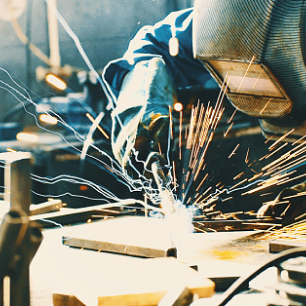Jump to:
What to Look for in Robotic Welding Systems
Welders remain in short supply, but the U.S. Bureau of Labor Statistics reports demand for the skill set is surging. From infrastructure development to automotive manufacturing, semiconductor processing and defense contracting, 70% of the products manufactured in America contain welded components (https://namcnetwork.com/blog/manufacturing-field-spotlight-welding/). Collaborative robots have emerged as a compelling solution for manufacturers struggling with the deficit. But despite efforts to simplify the technology, sophisticated hardware and software continue to hinder the use of cobots in a production environment, and navigating options for robotic welding systems can be difficult.
Shining a Spotlight on 7-Axis Robots
Programming requirements and 6-axis maneuverability can also limit the use of conventional cobots. Productive Robotics’ 7-axis, teach-by-touch Blaze robotic welding systems combine the capability of an industrial welding robot with the safety and simplicity of a cobot.
In addition, the company’s OB7 robot arms have seven moving joints to provide a greater degree of maneuverability and flexibility than 6-axis robots. “The elimination of user programming and the development of our 7-axis systems are the core technologies our company was formed around,” said Zac Bogart, president of Productive Robotics LLC. “There are industrial 7-axis robots, but we are currently the only U.S. company to provide 7-axis collaborative robots. It made sense to provide the welding community with the capability of a 7-axis robot arm that can reach around objects or obstacles and get into tighter and more confined work spaces.” For example, a human wrist can rotate, moving up and down and side to side; the model’s extra wrist joint continuously reorients the robotic arm while it moves the torch along the welding path, works continuously, and can eliminate the need for additional setups.
“Our arms have seven degrees of freedom from the shoulder to the hand,” Bogart said. “A welder is used to being able to manipulate the torch where needed. Having a robotic system with that same capability was a logical next step. A 7-axis robotic welding system can move in and around obstacles, such as a workpiece fixture, while maintaining the torch’s position.”
Considered an extra axis, it can avoid singularities and objects by placing the arm in different orientations as compared to what a 6-axis robot can achieve. “A 7-axis robotic welding system gives technicians and operators access to infinite maneuvering without restrictions,” Bogart said.
What’s Ideal to Use?
Evaluating a job shop or manufacturer’s part requirements can help determine which robotic welding system is best suited to the task at hand. Bogart added for gas metal arc welding applications, a mobile system is the best option for parts that are too large or heavy to place on a welding table. “For components that can be placed on a table, the Blaze LF’s 8-ft-long table [for example] gives manufacturers unrestricted access on all sides as well as easy loading and unloading of components. This type of setup also provides fabricators with the capability to automate processing of both large and small size weldments.”
Joining thin sheet metal is best suited to robotic laser welding that offers an effective alternative to gas tungsten arc welding. “With this system, an operator can fuse dissimilar metals of different thicknesses and create aesthetic high-strength joints with minimal or no wire consumption,” Bogart said.
Programming Importance
Aside from matching the right robotic welding system to the job, programming is another key area manufacturers need to consider. With features like teach pendants and technical vision, today’s cobots are typically more intuitive and easier to program. The teach-by-touch approach means an operator can simply touch the tip of the welding torch to the point he or she wants to weld.
Bogart added that an operator simply grasps the welding torch at the end of the product, touches it to the spot where the weld is to start, then touches it to the spot where the weld should end.
Recipes for common weld materials and weld types are preprogrammed with an unlimited number available. Complex jobs may include multiple formulas that are automatically adjusted during welding. Variables include welding speed, wire feed density and speed, welding voltage, preflow and postflow of welding gas, and different types of welds from weaving and skipping to stitch welds.
“It generally relies on a welder’s experience to know which welding settings are appropriate for the type of weld required,” Bogart said. “But once these settings are established, any operator regardless of welding experience can run the job in a matter of minutes. The recipe is part of the welding job, so when a particular weld job is run again in the future, the system will remember the settings and use them.”
Preprogrammed recipes also contribute to clean, precise welds by taking into account how materials affect weld variables. “For example,” he continued, “thicker material generally requires a lower torch speed and higher current.”
Conclusion
Advances in power supplies over the last decade have contributed to the ability to access recipes for highly refined welding parameters as well.
“Combining teach-by-touch, plug-and-play machines with a state-of-the-art power supply gives employees the capability to achieve perfect welds without struggling with robot jargon, tool points, and vector angles,” Bogart concluded.
This article was written by John Trengove (director of design at Productive Robotics LLC) for the American Welding Society.


